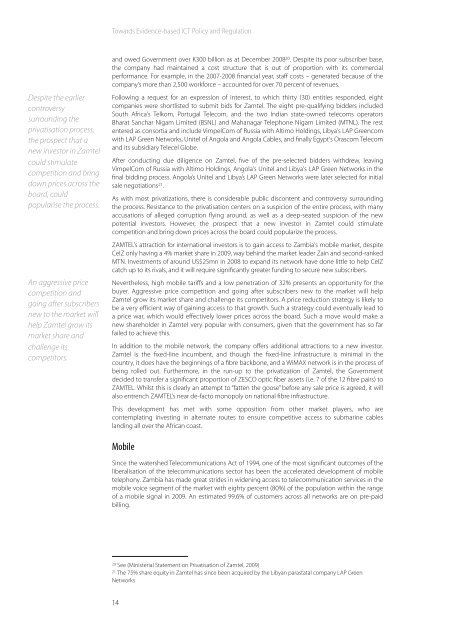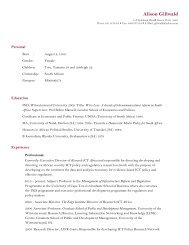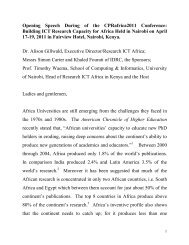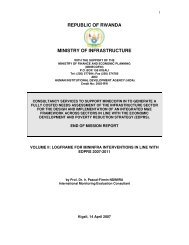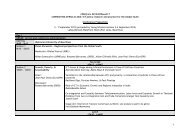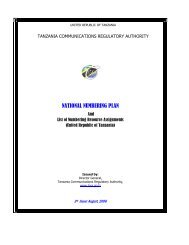Zambia ICT Sector Performance Review 2010 - Research ICT Africa
Zambia ICT Sector Performance Review 2010 - Research ICT Africa
Zambia ICT Sector Performance Review 2010 - Research ICT Africa
Create successful ePaper yourself
Turn your PDF publications into a flip-book with our unique Google optimized e-Paper software.
Towards Evidence-based <strong>ICT</strong> Policy and Regulation<br />
Despite the earlier<br />
controversy<br />
surrounding the<br />
privatisation process,<br />
the prospect that a<br />
new investor in Zamtel<br />
could stimulate<br />
competition and bring<br />
down prices across the<br />
board, could<br />
popularise the process.<br />
An aggressive price<br />
competition and<br />
going after subscribers<br />
new to the market will<br />
help Zamtel grow its<br />
market share and<br />
challenge its<br />
competitors.<br />
and owed Government over K300 billion as at December 2008 20 . Despite its poor subscriber base,<br />
the company had maintained a cost structure that is out of proportion with its commercial<br />
performance. For example, in the 2007-2008 financial year, staff costs – generated because of the<br />
company’s more than 2,500 workforce – accounted for over 70 percent of revenues.<br />
Following a request for an expression of interest, to which thirty (30) entities responded, eight<br />
companies were shortlisted to submit bids for Zamtel. The eight pre-qualifying bidders included<br />
South <strong>Africa</strong>'s Telkom, Portugal Telecom, and the two Indian state-owned telecoms operators<br />
Bharat Sanchar Nigam Limited (BSNL) and Mahanagar Telephone Nigam Limited (MTNL). The rest<br />
entered as consortia and include VimpelCom of Russia with Altimo Holdings, Libya's LAP Greencom<br />
with LAP Green Networks, Unitel of Angola and Angola Cables, and finally Egypt's Orascom Telecom<br />
and its subsidiary Telecel Globe.<br />
After conducting due diligence on Zamtel, five of the pre-selected bidders withdrew, leaving<br />
VimpelCom of Russia with Altimo Holdings, Angola's Unitel and Libya's LAP Green Networks in the<br />
final bidding process. Angola’s Unitel and Libya’s LAP Green Networks were later selected for initial<br />
sale negotiations 21 .<br />
As with most privatizations, there is considerable public discontent and controversy surrounding<br />
the process. Resistance to the privatisation centers on a suspicion of the entire process, with many<br />
accusations of alleged corruption flying around, as well as a deep-seated suspicion of the new<br />
potential investors. However, the prospect that a new investor in Zamtel could stimulate<br />
competition and bring down prices across the board could popularize the process.<br />
ZAMTEL's attraction for international investors is to gain access to <strong>Zambia</strong>'s mobile market, despite<br />
CelZ only having a 4% market share in 2009, way behind the market leader Zain and second-ranked<br />
MTN. Investments of around US$25mn in 2008 to expand its network have done little to help CelZ<br />
catch up to its rivals, and it will require significantly greater funding to secure new subscribers.<br />
Nevertheless, high mobile tariffs and a low penetration of 32% presents an opportunity for the<br />
buyer. Aggressive price competition and going after subscribers new to the market will help<br />
Zamtel grow its market share and challenge its competitors. A price reduction strategy is likely to<br />
be a very efficient way of gaining access to that growth. Such a strategy could eventually lead to<br />
a price war, which would effectively lower prices across the board. Such a move would make a<br />
new shareholder in Zamtel very popular with consumers, given that the government has so far<br />
failed to achieve this.<br />
In addition to the mobile network, the company offers additional attractions to a new investor.<br />
Zamtel is the fixed-line incumbent, and though the fixed-line infrastructure is minimal in the<br />
country, it does have the beginnings of a fibre backbone, and a WiMAX network is in the process of<br />
being rolled out. Furthermore, in the run-up to the privatization of Zamtel, the Government<br />
decided to transfer a significant proportion of ZESCO optic fiber assets (i.e. 7 of the 12 fibre pairs) to<br />
ZAMTEL. Whilst this is clearly an attempt to “fatten the goose” before any sale price is agreed, it will<br />
also entrench ZAMTEL’s near de-facto monopoly on national fibre infrastructure.<br />
This development has met with some opposition from other market players, who are<br />
contemplating investing in alternate routes to ensure competitive access to submarine cables<br />
landing all over the <strong>Africa</strong>n coast.<br />
Mobile<br />
Since the watershed Telecommunications Act of 1994, one of the most significant outcomes of the<br />
liberalisation of the telecommunications sector has been the accelerated development of mobile<br />
telephony. <strong>Zambia</strong> has made great strides in widening access to telecommunication services in the<br />
mobile voice segment of the market with eighty percent (80%) of the population within the range<br />
of a mobile signal in 2009. An estimated 99.6% of customers across all networks are on pre-paid<br />
billing.<br />
20 See (Ministerial Statement on Privatisation of Zamtel, 2009)<br />
21 The 75% share equity in Zamtel has since been acquired by the Libyan parastatal company LAP Green<br />
Networks<br />
14


